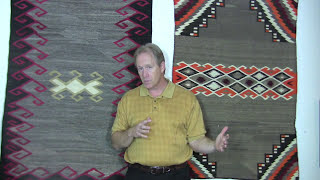Navajo Saddle Blankets
How to Identify a Saddle Blanket
By Dr. Mark Sublette, President / CEO of Mark Sublette Medicine Man Gallery

Navajo single saddle blanket, c. 1900s
Unlike some kinds of vintage Navajo blanket weaving that adhered to similar patterns and styles (such as Chief’s blankets), saddle blankets are much more free-form in design, reflecting more clearly the inner artistic vision of the weaver. Stylistically, Navajo saddle blankets can run the gamut with intricate geometric motifs, minimalist designs, representational pictorial images, names, initials, or ranch brands.
Like all saddle blankets, Navajo saddle blankets are intended to sit between a horse’s back and a saddle. Single saddle blankets fit neatly underneath the saddle, while double saddle blankets are folded in half lengthwise before use.

Navajo double saddle blanket, c. 1920s
Authentic Navajo saddle blankets are woven on the same type of loom used for all Navajo weaving: an upright, vertical loom that uses a continuous warp, meaning the foundational wool yarn used as the base of the rug isn’t cut off at the ends; instead, the warp thread wraps from the bottom of the loom, back to the top, loops down again to the bottom, then loops to the top and so on. The design is then woven using the weft yarn, which is worked horizontally in sections.
The wool used in Navajo saddle blankets varies depending on the time the blanket was made, as it does with other kinds of Navajo weavings. Earlier weavings from the 1870s to 1910s often used hand-spun churro wool - silky, long-fiber wool from sheep popular in the Navajo flocks of the time.

Navajo single saddle blanket with multicolored tassels, c. 1920s
Another kind of wool was used by weavers during the Germantown yarn era from 1885 to 1910. The earliest of these weavings were made with cotton twine warps (instead of much stronger wool yarn) and didn’t withstand actual use under a saddle. As such, Germantown saddle blankets that are in good condition are particularly collectible.
In the heyday of Navajo saddle blanket weaving from 1900 to 1930, saddle blankets were made with homespun wool, either in natural colorations or dyed with synthetic aniline dyes in a range of hues. Saddle blankets may have added tassels on one end to add an extra visual punch during use under the saddle.

